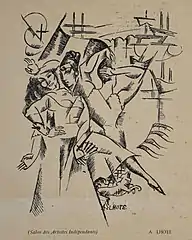André Lhote
André Lhote (5 July 1885 – 24 January 1962) was a French Cubist painter of figure subjects, portraits, landscapes and still life. He was also very active and influential as a teacher and writer on art.
André Lhote | |
|---|---|
 André Lhote, 1925 | |
| Born | 5 July 1885 Bordeaux, France |
| Died | 24 January 1962 (aged 76) Paris, France |
| Nationality | French |
| Movement | |
| Awards | Grand Prix National de Peinture 1955 |
Early life and education
Lhote was born 5 July 1885 in Bordeaux, France, and learned wood carving and sculpture from the age of 12, when his father apprenticed him to a local furniture maker to be trained as a sculptor in wood. He enrolled at the École des Beaux-Arts in Bordeaux in 1898 and studied decorative sculpture until 1904.[1]
Whilst there, he began to paint in his spare time and he left home in 1905, moving into his own studio to devote himself to painting. He was influenced by Gauguin and Cézanne and held his first one-man exhibition at the Galerie Druet in 1910, four years after he had moved to Paris.[2]
Career
After initially working in a Fauvist style, Lhote shifted towards Cubism and joined the Section d'Or group in 1912, exhibiting at the Salon de la Section d'Or. He was alongside some of the fathers of modern art, including Gleizes, Villon, Duchamp, Metzinger, Picabia and La Fresnaye.
The outbreak of the First World War interrupted his work and, after discharge from the army in 1917, he became one of the group of Cubists supported by Léonce Rosenberg. In 1918, he co-founded Nouvelle Revue Française, the art journal to which he contributed articles on art theory until 1940.
Lhote taught at the Académie Notre-Dame des Champs from 1918 to 1920, and later taught at other Paris art schools—including the Académie de la Grande Chaumière and his own school, Academy André Lhote which he founded in Montparnasse in 1922.[3] His students included Henri Cartier-Bresson, Conrad O'Brien-ffrench, Elena Mumm Thornton Wilson, Adamson-Eric, Simon Elwes, Kuno Veeber, Charlotte van Pallandt, Wesley E. Johnson, Sava Šumanović, Margaret Lefranc, Shirley Russell, Gwyneth Johnstone, Paul Kane, Julie van der Veen, Michael Wishart, Lino Spilimbergo, Tamara de Lempicka, Sarah Marindah Baker,[4] Genevieve Pezet,[5] and Helen Stewart.
Lhote lectured extensively in France and other countries, including Belgium, England, Italy and, from the 1950s, also in Egypt and Brazil. In Egypt, Lhote worked with Effat Nagy using Egyptian archaeology as subject matter for their work.[6]
His work was rewarded with the Grand Prix National de Peinture for 1955, and the UNESCO commission for sculpture appointed Lhote president of the International Association of Painters, Engravers and Sculptors.
Death
Lhote died in Paris in 1962.[7]
Gallery of works
 French Landscape, 1912, oil on canvas, 89 x 116 cm, Musée des Beaux-Arts de Bordeaux
French Landscape, 1912, oil on canvas, 89 x 116 cm, Musée des Beaux-Arts de Bordeaux L'Escale (The Stopover), 1913, oil on canvas, 210 x 185 cm, Musée d’Art Moderne de la Ville de Paris
L'Escale (The Stopover), 1913, oil on canvas, 210 x 185 cm, Musée d’Art Moderne de la Ville de Paris Sketch for L'Escale, 1913, published in Montjoie!, n.5, 14 April 1913
Sketch for L'Escale, 1913, published in Montjoie!, n.5, 14 April 1913 14 July, Port de Bordeaux-Poincaré, 1913–14, oil on canvas, 65 x 81.5 cm, private collection
14 July, Port de Bordeaux-Poincaré, 1913–14, oil on canvas, 65 x 81.5 cm, private collection.jpg.webp) Baigneuses, 1917, Musée des Beaux-Arts de Caen.
Baigneuses, 1917, Musée des Beaux-Arts de Caen.
References
- Images and Insights, Hugh Lane Municipal Gallery Of Modern Art, 1993, ISBN 0951424637
- Reginald Howard Wilenski, Modern French Painters, Harcourt, Brace, 1949
- "Andre Lhote | French artist". Encyclopedia Britannica. Retrieved 2017-11-21.
- Jules Heller; Nancy G. Heller (19 December 2013). North American Women Artists of the Twentieth Century: A Biographical Dictionary. Routledge. ISBN 978-1-135-63882-5.
- Akoun, J. P. A. (2005). Akoun: répertoire biographique d'artistes de tous pays des XIXe et XXe siècles. CV-XIX-XX. Cote de l'amateu. p. 603. ISBN 9782859174293.
- Pioneers: Saad El-Khadem and Effat Nagy Museum, Youmna Salah, 1 January 2011, Masress.com, Retrieved 17 September 2015
- "André Lhote | artnet". www.artnet.com. Retrieved 2017-11-21.
External links
| Wikimedia Commons has media related to André Lhote. |